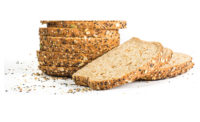A new regular feature in Snack Food & Wholesale Bakery magazine, “Culinology® Perspectives” will offer unique inspiration from the leadership ranks of the Research Chefs Association.
For our inaugural installment, we reached out to Chef Michael Holleman, director of culinary development, InHarvest, Inc., Bemidji, MN, a leading culinary expert on use of grains across the food industry, including retail and foodservice. He received the prestigious RCA Lifetime Achievement Award in 2013 for his widely recognized contributions to the field of Culinology. Holleman is also the current chair of the Culinary Advisory Committee of the Whole Grains Council.
 Douglas J. Peckenpaugh: What are some of the top grain trends you are seeing in baked goods like breads, buns and rolls in restaurants and retail bakeries today?
Douglas J. Peckenpaugh: What are some of the top grain trends you are seeing in baked goods like breads, buns and rolls in restaurants and retail bakeries today?
Michael Holleman: Ancient grains, more than “whole grains”—which ancient grains are—are dominating the baked goods category, both at retail and foodservice. Consumers want to know that what you are offering them is new and interesting, not just healthy and delicious. Ironically, what’s old is new again: “Ancient” is still new when it comes to grains.
For example, wild rice, which is a distinctly North American whole, ancient grain, is a star ingredient in St. Paul, MN–based Franklin Street Bakery’s wildly successful wild-rice sandwich breads. Along with crushed wheat, locally sourced wild rice is incorporated into the combination enriched-wheat-flour and whole-wheat-flour dough. The narrow-type loaves (4¼ in. to 4¾ in. wide) are thick-sliced (¾ in.) and medium-sliced (½ in.) for retail. One variety, Cranberry Wild Rice Vienna Grand Bread, also features locally harvested cranberries and is the 21-year-old wholesale bakery’s most-popular bread. So loved is the product regionally that it’s sold as 24-oz. medium-sliced loaves at all Kwik Trip convenience stores in Iowa, Minnesota and Wisconsin.
DJP: What are some of the most-interesting culinary uses of grains that you are seeing in menu segments like small plates and appetizers?
MH: At Harvest, an upscale restaurant in Madison, WI, one of several inspired first courses is pan-seared scallops with puffed grains, grilled pineapple and Tobiko caviar plated with a coconut-milk and lemongrass reduction. Staple & Fancy in Seattle offers a baby-beets appetizer crowned with puffed wild rice and accompanied by white anchovies and avocado, all accented with white balsamic vinegar.
Indeed, puffed grains are gracing small plates as an accent inclusion, but are also the value add when it comes to marketing the left side of the menu. Puffed grains that are introduced to uninitiated diners via first courses and appetizers have real power to wow—and command a higher menu price—because they represent a novel, less-risk-on-the-taste-buds way to present whole grains to the adult palate while hearkening to the beloved crisp-rice breakfast cereals and chewy/crunchy puffed-rice snacks of childhood. Quinoa is fast-becoming the puffed grain of choice on full-service restaurants’ appetizer menus, because it simultaneously proffers the mouthfeel of nostalgia and delivers a generous pinch of the exotic.
As examples, a puffed-quinoa grain-and-fruit salad buddies-up alongside the Muddy Shoes Burger, a good-selling meatless sandwich offering at The Poppyseed Restaurant in Blasdell, NY. Puffed quinoa also impresses in a hamachi-ceviche lunch appetizer—a bright-tasting, Japan-inspired option—at Hawksworth in Vancouver, British Columbia. In a case of inspired menu marketing, Juniper & Ivy Left Coast Cookery in San Diego transcends “puffed” with “crispy” quinoa as a selling point to a small plate of madras-curry salami, currants, Maui sweet onion and Greek yogurt.
While more and more chefs are discovering puffed whole grains, they’ve long relied on the value-added standby of toasting grains to enhance the umami taste-sense of a dish, as well as promote a pleasant contrast to mouthfeel. Today, the opportunity for chefs who rely on toasted grains to help sell first courses and small plates is to experiment with toasting less-familiar—but interesting—ancient grains, such as whole-grain amaranth and black barley.
DJP: What are some of the top grain trends today in common bakery products, across both retail and foodservice?
MH: Anything that fits under the whole-grain umbrella is still hot with consumers, but even hotter are products marketed as “ancient grain” and “GMO free.” None of these is a new buzz word or box we need to check, but all continue to climb in every segment we service.
Quinoa is still a driving force, but it’s taking on newly different forms such as flakes, flour, puffed and toasted. We are finally seeing the quinoa market stabilize after a roller-coaster several years.
DJP: What are some grains that you see as having potential as “the next big thing”?
MH: Be on the lookout for grains such as sorghum, millet and teff that are not as well known in the U.S. market to start taking their rightful places in the continuing whole-grain movement, with sorghum at the top of that list. These grains also offer solutions to the still-growing gluten-free category. Amaranth should also be included, even though it has been on the radar for a couple of years now. Sorghum is the easiest of the four to work with application-wise, but all are nutrition powerhouses.
Right now we are also seeing sprouted grains growing rapidly, as supply is finally available with a zero micro count thanks to modern processing techniques.
DJP: How can some of these specific grains bring new flavor and texture diversity into snacks and baked goods?
MH: Many seem to think all grains are created equal in regard to cooking ease and flavor profiles, but nothing could be further from the truth. From the umami quality of greenwheat freekeh and the starch release of amaranth, there is much to consider when choosing the right grain for your application. Further processing of grains is enabling additional flavor profiles and textures; puffed, toasted and crispy are common descriptors. Chefs and food scientists are looking more toward grains that are processed as “intact” vs. the extruded puffed grains that have dominated the cereal industry until recently. We see granola bars, including ancient-grain, protein and nutrition-supplement bars, as having the largest growth pattern for snacks in the already-saturated bar category.
DJP: How does the discipline of Culinology factor into your day-to-day work as a product development chef?
MH: One might question how much the rice and grain world would require the integration of food science on a daily basis, but it is becoming an absolute necessity with the rapid rise in whole-grain products being produced. As with any escalating trend, innovation is key to continued success as a supplier and manufacturer. And with innovation comes new technology and processing methods, which in turn push quality assurance (QA) to be ahead of the curve with documentation on food safety and best manufacturing practices. SQF and BRC certifications are ensuring food safety at the highest levels, now a requirement by many of today’s largest manufacturers. In all product development, we rely on QA and food-science integration to keep our gold standard with zero compromise in food safety.





